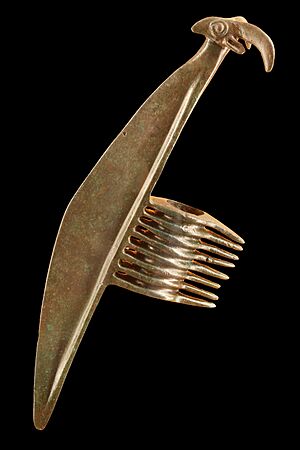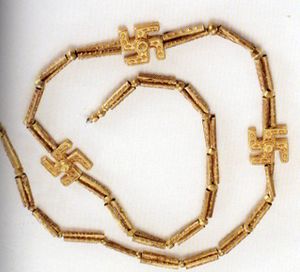History of Gilan facts for kids
Gīlān is a province in Iran, located on the southwestern coast of the Caspian Sea. This article explores its long history.
Contents
Ancient History of Gilan
For many centuries, until about 600 AD, Gilan was influenced by powerful empires that ruled Iran. These included the Achaemenid, Seleucid, Parthian, and Sasanid empires.
Around 100 or 200 BC, a group of people called the Gelae (or Gilites) likely moved into the region. They settled south of the Caspian Sea and west of the Amardos River (now called the Safidrud). Some historians believe they replaced an older group called the Cadusii. It's thought that the Gelae came from the Dagestan region.
Interestingly, people from Gilan, called Gilaks, have genes that are similar to people from the Caucasus region, like the Georgians. Their language also shares some features with Caucasian languages. This suggests their ancestors might have come from the Caucasus.
Later, these new groups, along with the Deylamites, moved across the Amardos River. They became known as fierce fighters and sometimes worked as soldiers for the Sasanian kings.
Gilan in the Early Islamic Period
When the Islamic period began, the Gilaks lived in the lowlands along the sea, east of the Safidrud river. This area was called Bīa-pīš. West of the Safidrud, in an area called Bīa-pas, Gilaks lived in the lowlands north of Tārom. The Talesh region was on their western border.
Unlike many other areas, Arabs did not conquer Gilan. Some old records say Gilan paid taxes to the Abbasid Caliphate early on, but this probably only applied to western Gilan. The Deylamites, who lived in the mountains, strongly protected eastern Gilan from Muslim attacks.
The Gilaks and Deylamites spoke a special dialect of Persian that was hard for other Persian speakers to understand. In the late 800s and early 900s, many people in Gilan converted to Islam. In western Gilan, Sunnite Islam was introduced by a scholar from Āmol. In eastern Gilan, a leader named Ḥasan b. ʿAlī Oṭrūš al-Nāṣer le’l-Ḥaqq taught Zaydī Shiʿism. For many centuries, this led to a split between the Sunnite west and the Zaydī east of Gilan, which also divided them politically.
Even after the Deylamites expanded their power, Gilan remained somewhat independent. Powerful groups like the Ziarids and Buyids tried to control Gilan and sometimes collected taxes, but they couldn't fully govern the region. Local leaders, often from powerful families, controlled the country.
In the 12th century, Lahijan became an important center for the Alids in eastern Gilan, replacing Hawsam. Lahijan, now the largest town in eastern Gilan, was once considered a Deylamite area.
Gilan stayed independent for a while even when the Mongol Ilkhanids ruled much of Iran. In 1306, the Il-khan Oljāytū tried to conquer Gilan. His forces suffered heavy losses, and he only gained a small amount of control. Gilan was part of the Il-khanid empire but was still mostly ruled by its local families.
Later, in the late 1300s, a Zaydī leader named ʿAlī Kia took control of eastern Gilan. He and his family ruled from Lāhījān until the early Safavid era. In western Gilan, the Esḥāqvand family, who were Sunnite, gained power from the mid-1200s. They ruled from Fuman and controlled all of western Gilan. Both of these ruling families were removed by the Safavid Shah ʿAbbās I in 1592. After this, governors appointed by the central government ruled Gilan.
Gilan During the Safavid Era
In the late 1400s and early 1500s, two local families ruled Gilan. The Amīra Dobbāj family, who were Sunnite, ruled western Gilan (Bīa-pas) from Fuman and later Rasht. The Shiite Amir Kia family ruled eastern Gilan (Bīa-pīš) from Lahijan. Both families claimed to be related to ancient Sasanian kings.
Gilan briefly recognized the Ottoman Empire's authority twice, in 1534 and 1591, but they didn't actually pay taxes to the Ottomans.
The Safavid emperor, Shah Abbas I, ended the rule of Khan Ahmad Khan, who was the last semi-independent ruler of Gilan. Shah Abbas I took direct control of the province in 1592. From then on, the Persian Shah appointed Gilan's rulers.
During the Safavid, and later the Qajar periods, many people from the Caucasus region, like Georgians, Circassians, and Armenians, were settled in Gilan. Their descendants still live there today. Many of these Georgians and Circassians have blended into the main Gilaks population.
Towards the end of the 1600s, the Safavid empire became weak. By the early 1700s, the empire was in a civil war. Peter I of Russia (Peter the Great) saw this as a chance to expand his empire. His forces captured Rasht and the rest of Gilan during the Russo-Persian War (1722–23). This war led to Russia taking control of northern Iranian lands. Gilan became part of the Russian Empire under the Treaty of Saint Petersburg of 1723. However, Gilan was returned to Persia, which was then led by Nader Shah, just 10 years later after the Treaty of Resht.
Gilan in the 18th and 19th Centuries
In the early 1700s, as the Safavid empire fell, Iran became very unstable. Other countries, especially Russia, became interested in taking over parts of Iran. During this time, Gilan was mostly ruled by local leaders. These leaders either governed independently or paid taxes to stronger groups to keep their freedom. The division of Gilan into Bīa-pas and Bīa-pīš continued.
Gilan was a major producer of silk starting in the 1400s. This made it one of the wealthiest provinces in Iran. The Safavid empire wanted to control Gilan partly because of the money from silk. The silk trade was controlled by the government and was a huge source of income for the empire. Until the mid-1800s, Gilan was the biggest exporter of silk in Asia. The Shah allowed Greek and Armenian merchants to handle this trade, and in return, he received a large share of the profits.
In the mid-1800s, a terrible disease spread among the silkworms. This caused a huge economic problem in Gilan, leading to widespread financial hardship. The business owners and merchants in Gilan became very unhappy with the weak rule of the Qajars. To deal with the silk decline, Gilan started growing more rice and introduced tea plantations.
Gilan in the 20th Century
After World War I, Gilan became somewhat independent from the central government in Tehran. There was concern that the province might separate completely. Before the war, people from Gilan had played a big part in the Constitutional Revolution of Iran. Sepahdar-e Tonekaboni was an important leader who helped defeat Mohammad Ali Shah Qajar.
In the late 1910s, many Gilakis joined forces under the leadership of Mirza Kuchik Khan. He became a very important revolutionary leader in northern Iran. Khan's group, known as the Jangal movement of Gilan, sent soldiers to Tehran. These soldiers helped remove the Qajar ruler Mohammad Ali Shah. However, the revolution didn't go as planned, and Iran faced a lot of internal problems and interference from other countries, especially Britain and Russia.
During and after the October Revolution in Russia, many Russian settlers, called White émigrées, came to Gilan. Many of their descendants still live in the region. At this time, Anzali was the main port for trade between Iran and Europe.
The Jangalis are celebrated in Iranian history for protecting Gilan and Mazandaran from foreign invasions. But in 1920, British forces invaded Bandar-e Anzali, with the Bolsheviks chasing them. In this conflict between Britain and Russia, the Jangalis teamed up with the Bolsheviks against the British. This led to the creation of the Persian Socialist Soviet Republic (also known as the Socialist Republic of Gilan), which lasted from June 1920 to September 1921.
In February 1921, the Soviets stopped supporting the Jangali government in Gilan. They signed the Russo-Persian Treaty of Friendship (1921) with the central government in Tehran. The Jangalis continued to fight against the central government until they were finally defeated in September 1921. After this, Tehran regained control of Gilan.
Russian Occupations of Gilan
In 1722, Rasht was under attack by Afghans. The new Safavid king, Shah Ṭahmāsb II, asked Russia for help. The governor of Gilan requested assistance from the Russian czar, Peter the great. Peter sent soldiers to Gilan, but they were not welcomed. The Shah then asked them to leave, but they refused. This led to a battle where the Russian soldiers defeated a much larger Iranian force.
Peter then sent more soldiers. A treaty was signed that gave Russia control of Gilan, Māzandarān, Astarābād, Ṭāleš, Baku, and Derbent. However, the Russians left Gilan in 1734, returning all these areas in the Caucasus and Caspian Sea region.
After the Qajars lost several wars to Russia (the 1804–1813 and 1826–28), Russia gained a lot of influence in the Caspian region. This influence lasted until 1946.
As mentioned, during and after the October Revolution, many Russian settlers came to Gilan. Many of their descendants still live there. During this time, Anzali was a very important port for trade between Iran and Europe.
Groups Who Settled in Gilan
During the Safavid, Afsharid, and Qajar periods, many people from the Caucasus region settled in Gilan. These included Georgians, Circassians, and Armenians. Their descendants still live across Gilan today, and many have become part of the Gilaki community.




